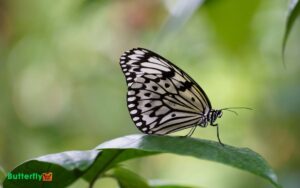What Colors Define Monarch Butterflies?
Monarch butterflies exhibit a striking coloration characterized by vibrant orange wings, prominently bordered and veined with black. Their wing patterns feature white spots, particularly along the black margins, aiding species identification and predator deterrence.
This coloration, derived from the beta-carotene in their milkweed diet, serves both as aposematic signaling to predators of their toxicity and assists in thermoregulation essential for flight. Seasonal variations and gender differences further influence their pigmentation patterns, impacting survival and reproductive success.
Understanding these intricate color adaptations provides deeper insights into their survival strategies and ecological interactions.

Key Takeaways
- Monarch butterflies have distinct orange wings, derived from beta-carotene in their milkweed diet.
- Black outlines and veins on wings enhance structural integrity and visibility.
- White spots on the wings aid in species identification and predator deterrence.
- Seasonal color variations occur, with darker pigmentation in cooler months and lighter in warmer periods.
Orange Wings
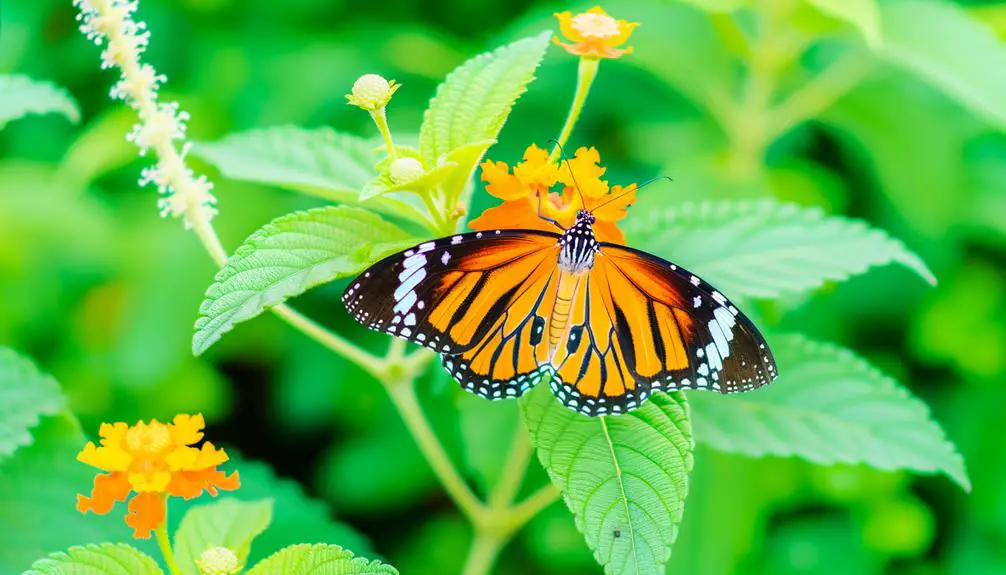
The distinct orange wings of monarch butterflies (Danaus plexippus) serve as a critical adaptation for their survival, functioning primarily as a warning signal to potential predators about their toxicity.
The orange pigmentation, known as beta-carotene, is derived from their larval diet of milkweed plants, which contain toxic cardenolides. These toxins render the butterflies distasteful and potentially harmful to predators, such as birds.
This aposematic coloration effectively deters predation, enhancing monarchs' survival rates. Additionally, the vivid orange hue plays a role in thermoregulation, aiding in heat absorption and maintaining ideal body temperatures for flight.
This dual functionality highlights the evolutionary advantage of their striking coloration, balancing both defensive and physiological needs, thereby facilitating their enduring presence across diverse habitats.
Black Outlines
The black outlines on monarch butterflies' wings serve to define the borders, providing a stark contrast that enhances the visibility of the orange and white patterns.
These black veins and borders not only contribute to the distinct visual appearance but also play an essential role in the structural integrity and function of the wings.
The pigmentation and arrangement of these black elements are integral to both the butterfly's aerodynamics and camouflage mechanisms.
Defining Wing Borders
Distinct black outlines border the vibrant orange wings of monarch butterflies, serving both as a deterrent to predators and an aid in thermoregulation.
These black margins offer several functional advantages:
- Predator deterrence: The stark contrast between black and orange can signal toxicity, warning potential predators.
- Heat absorption: The black pigment absorbs sunlight more efficiently, aiding in maintaining ideal body temperature.
- Structural reinforcement: The melanized borders provide additional strength to the wings, reducing damage during flight.
These delineated borders exemplify evolutionary adaptations that enhance survival and ecological success, demonstrating the intricate interplay between form and function in monarch butterflies.
Black Veins Function
In addition to the black margins, the black veins traversing the wings of monarch butterflies play pivotal roles in physiological and ecological functions.
These veins are integral to the structure, providing rigidity and strength necessary for sustained flight. They house hemolymph, facilitating nutrient transport and thermoregulation, which are critical for the butterfly's survival.
Ecologically, the black veins enhance visual signaling, aiding in species recognition and predator deterrence through aposematic coloration. The arrangement and prominence of these veins also contribute to aerodynamic efficiency, optimizing flight mechanics.
Consequently, the black veins are not merely aesthetic features but essential components that underscore the monarch's adaptability and resilience in diverse environmental contexts.
White Spots
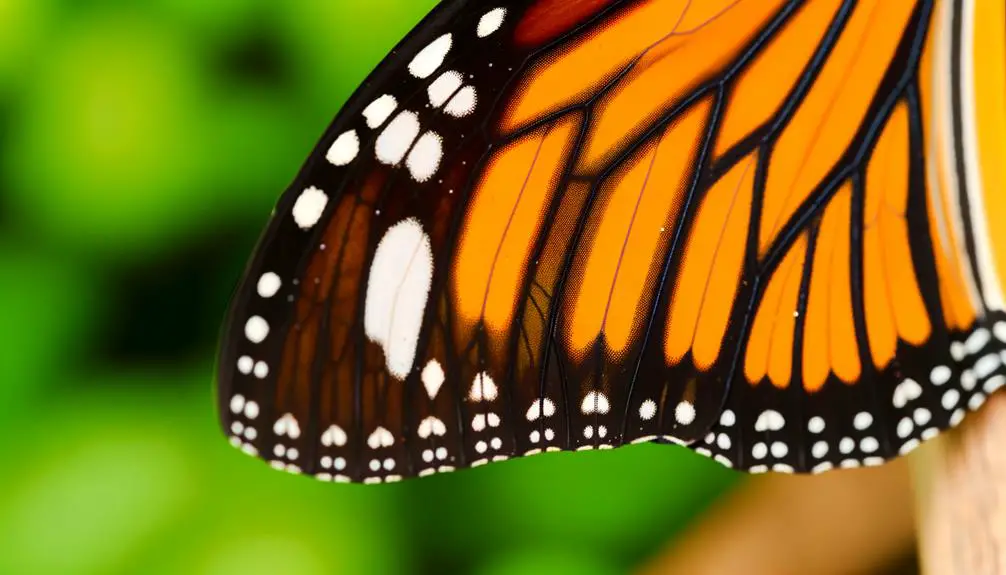
Characterized by their striking white spots, monarch butterflies exhibit these markings prominently along the edges of their wings, contributing to both their visual appeal and species identification.
These white spots serve several functional purposes:
- Species Recognition: White spots aid in the identification of conspecifics, facilitating mating and social interactions.
- Predator Deterrence: The contrasting white spots may act as a warning signal to potential predators, indicating toxicity.
- Camouflage: In certain environments, these spots can help blend the butterfly into dappled light conditions, reducing predation risks.
These spots are not merely cosmetic; they are integral to the monarch's survival and ecological interactions.
Color Variations
Monarch butterflies exhibit a range of color variations that are influenced by several factors.
The classic orange hue, characteristic of the species, can undergo seasonal changes due to environmental conditions.
Additionally, gender-based differences contribute to distinct coloration patterns, with males typically displaying brighter and more vivid colors compared to females.
Classic Orange Hue
The classic orange hue of monarch butterflies is a result of the selective absorption and reflection of specific wavelengths of light by pigments in their wing scales. These pigments, primarily carotenoids, are responsible for the vibrant coloration that serves multiple functions:
- Predator Deterrence: The bright orange color acts as a warning signal to predators about the toxicity of the butterfly, derived from milkweed ingestion.
- Thermoregulation: The orange and black coloration aids in absorbing sunlight, which is essential for warming their flight muscles.
- Species Identification: The distinct color pattern facilitates recognition among conspecifics, aiding in mating and social interactions.
This multifaceted coloration exemplifies evolutionary adaptation.
Seasonal Color Changes
Seasonal variations in the coloration of monarch butterflies are influenced by changes in temperature and photoperiod, resulting in subtle shifts in pigment intensity and distribution. During cooler months, monarchs exhibit darker wing pigmentation, which aids in thermoregulation by absorbing more solar radiation. Conversely, in warmer periods, the pigmentation tends to be lighter, reducing heat absorption. These color changes are not drastic but are significant enough to impact the butterflies' survival and reproductive success.
| Season | Coloration Characteristics |
|---|---|
| Winter | Darker pigmentation, increased melanin |
| Spring | Moderate pigmentation, balanced tones |
| Summer | Lighter pigmentation, reduced melanin |
| Fall | Gradual darkening, preparation for migration |
Understanding these variations provides insight into the adaptive strategies of monarch butterflies in response to environmental changes.
Gender-Based Differences
Gender-based differences in the coloration of monarch butterflies manifest primarily through variations in wing pigmentation and venation patterns, which are influenced by genetic and hormonal factors.
Male monarchs typically exhibit darker, more vibrant orange hues compared to females. Additionally, males possess two distinctive black spots on their hindwings, known as androconial patches, which are absent in females. Females, conversely, display thicker black vein lines across their wings, contributing to a somewhat more subdued coloration.
Key gender-specific differences include:
- Wing pigmentation intensity: Males exhibit brighter orange tones.
- Presence of androconial patches: Males have black spots on hindwings.
- Venation pattern thickness: Females show thicker black veins.
These distinctions facilitate gender identification and play roles in mating behaviors.
Seasonal Changes
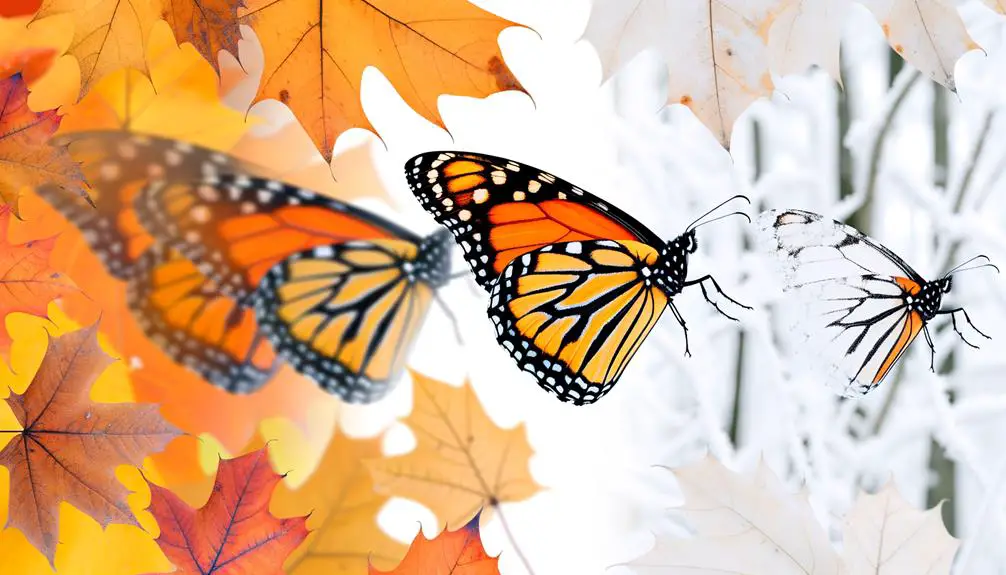
Throughout the year, monarch butterflies exhibit significant phenotypic variations in response to seasonal changes in their environment.
These variations primarily manifest in the intensity and brightness of their wing coloration. During the summer months, monarchs display more vibrant and saturated orange hues, which are believed to be linked to ideal sunlight exposure and abundant nutritional resources.
Conversely, as autumn approaches and they prepare for migration, their wing colors often become duller and more muted. This change may be an adaptive response to reduced UV radiation and cooler temperatures, enhancing their energy reserves for the long journey ahead.
Additionally, seasonal changes in pigmentation can influence their ability to thermoregulate, affecting flight performance and survival during different climatic conditions.
Role of Pigmentation
The varying wing coloration observed in monarch butterflies not only reflects seasonal adaptations but also underscores the significant role of pigmentation in their survival and ecological interactions.
Pigmentation in monarch butterflies serves several vital functions:
- Thermoregulation: Darker pigments absorb more sunlight, aiding in maintaining ideal body temperatures.
- Camouflage: Wing patterns help them blend into their surroundings, reducing predation risks.
- Mate Selection: Vibrant coloration is often a determinant in mate choice, influencing reproductive success.
Understanding these pigmentation roles provides insight into the adaptive strategies monarch butterflies employ for survival and highlights their complex interplay with the environment.
Warning Signals
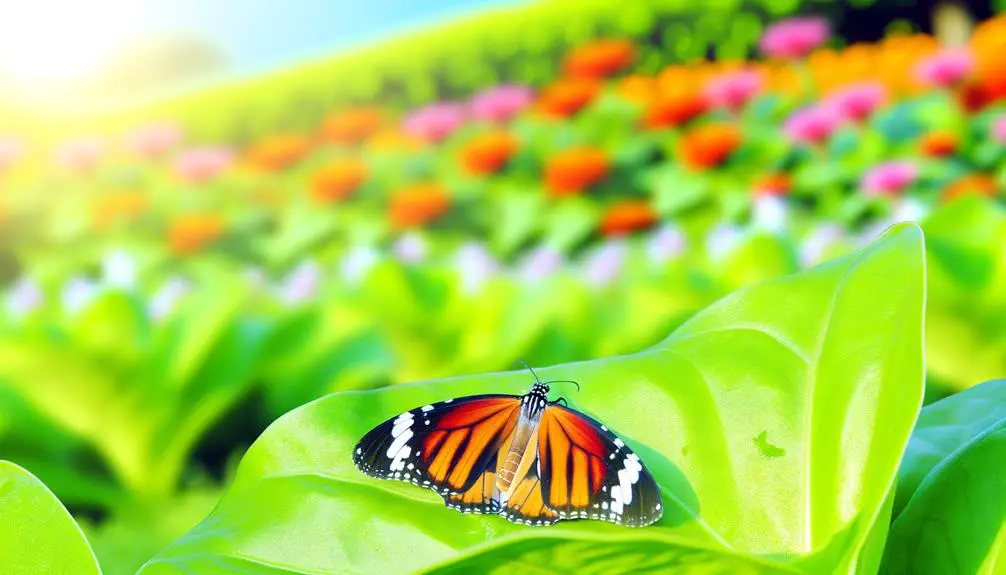
Many monarch butterflies exhibit bright, contrasting wing colors that serve as aposematic signals to potential predators.
These vivid orange and black patterns function as effective warning signals, indicating the presence of toxic compounds such as cardenolides, which monarchs sequester from milkweed plants during their larval stage.
The conspicuous coloration enhances predator learning and memory, reducing the likelihood of repeated attacks.
Birds and other predators quickly associate the striking wing patterns with unpalatability and potential toxicity, thereby avoiding monarch butterflies as prey.
This evolutionary adaptation not only benefits the butterflies by lowering predation rates but also plays an essential role in the broader ecological dynamics, influencing predator-prey interactions and contributing to the survival of these iconic lepidopterans.
Camouflage and Mimicry
In addition to their aposematic coloration, monarch butterflies also exhibit forms of camouflage and mimicry to enhance their survival against predation. These strategies are vital for evading predators in their natural habitats.
Monarchs use the following adaptive mechanisms:
- Seasonal Color Variations: Subtle changes in wing tones help them blend with different seasonal backgrounds.
- Behavioral Camouflage: By folding their wings, monarchs minimize visibility, resembling leaves or twigs.
- Mimicry: Monarchs are often mimicked by the viceroy butterfly, which shares similar coloration to deter predators.
These adaptive behaviors are essential for monarchs to navigate their environments and evade potential threats, thereby enhancing their prospects for survival.
Impact on Migration

Understanding the impact on migration is essential for comprehending how environmental factors and genetic predispositions influence the migratory patterns of monarch butterflies. Climatic variations, such as temperature and precipitation, considerably affect their migratory timing and pathways.
Monarchs exhibit an innate genetic inclination toward specific migratory routes, which are fine-tuned by environmental cues. Additionally, changes in habitat quality due to deforestation and urbanization disrupt traditional migratory corridors.
The butterflies' distinctive orange and black coloration plays a key role in thermoregulation, aiding in efficient energy management during long-distance flights. Furthermore, exposure to pesticides and pollutants further exacerbates the stress on migratory populations.
Hence, a multifaceted approach, integrating ecological conservation and genetic research, is essential for safeguarding monarch migration.
Conclusion
The chromatic splendor of monarch butterflies, characterized by vibrant orange wings bordered with black outlines and accented by white spots, represents one of nature's most striking palettes.
Seasonal variations and pigmentation play critical roles in their survival, providing both warning signals to predators and camouflage through mimicry.
The impact of these colors on migration is nothing short of phenomenal, as these tiny organisms traverse vast distances with uncanny precision, showcasing an evolutionary masterpiece in the animal kingdom.






